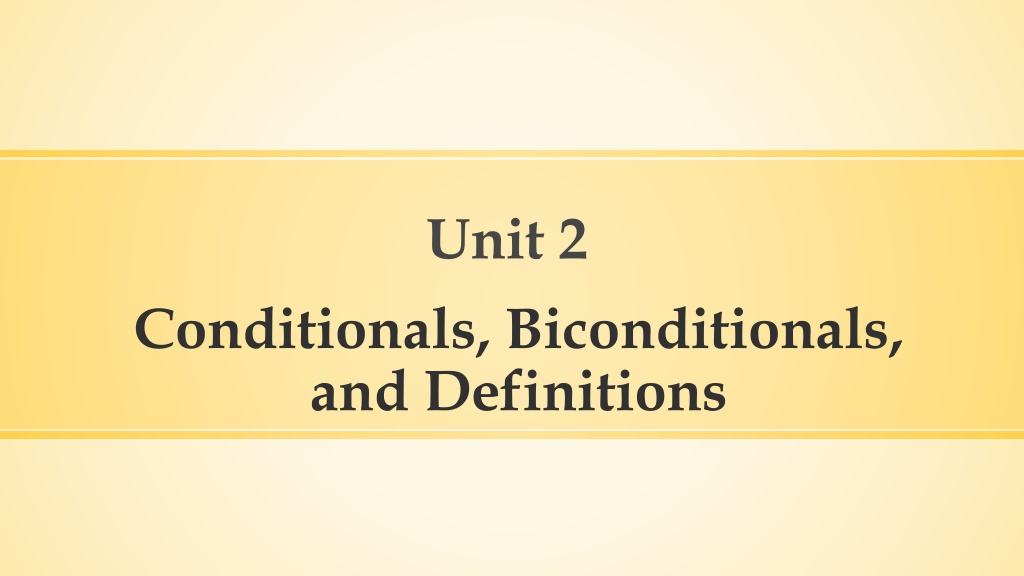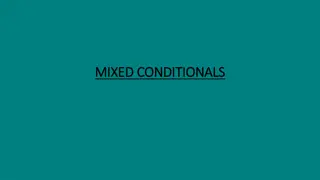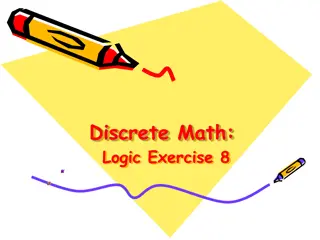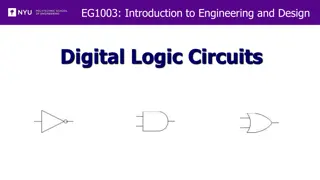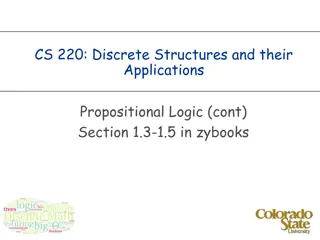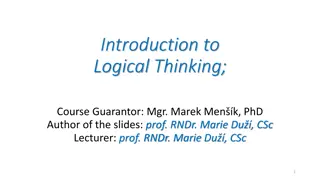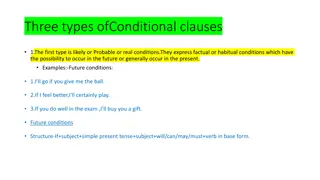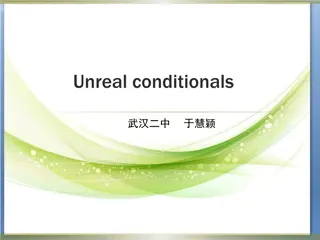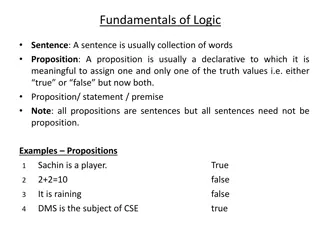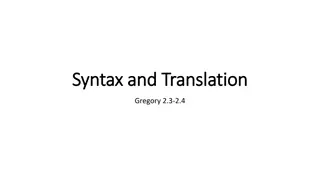Understanding Conditionals and Biconditionals in Logic
Conditional statements, also known as if-then statements, play a crucial role in logic. They consist of a hypothesis (following "if") and a conclusion (following "then"). By identifying the hypothesis and conclusion, writing conditional statements, evaluating truth values, and exploring converses, one can grasp the fundamental concepts of conditionals and biconditionals.
Download Presentation

Please find below an Image/Link to download the presentation.
The content on the website is provided AS IS for your information and personal use only. It may not be sold, licensed, or shared on other websites without obtaining consent from the author. Download presentation by click this link. If you encounter any issues during the download, it is possible that the publisher has removed the file from their server.
E N D
Presentation Transcript
Unit 2 Conditionals, Biconditionals, and Definitions
Conditional Statements Conditional statements can also be referred to as if-then statements. Example: If you are not completely satisfied, then your money will be refunded. Every conditional has two parts. They are: Hypothesis The part following if Conclusion The part following then
Identifying the Hypothesis and Conclusion Example 1: If today is the first day of fall, then the month is September. Hypothesis: ______________________________ Conclusion: ______________________________ Example 2: If y 3 = 5, then y = 8. Hypothesis: ______________________________ Conclusion: ______________________________
Writing a Conditional Statement Write each sentence as a conditional. Example 1: A rectangle has four right angles. _____________________________________________________ Example 2: A tiger is an animal. _____________________________________________________ Example 3: An integer that ends with 0 is divisible by 5. _____________________________________________________
Truth Value Examples: Conditionals can have a truth value, which is either true or false. To show that a conditional is true, show that every time the hypothesis is true, the conclusion is also true. Show that his conditional is false by finding a counterexample: If it is February, then there are only 28 days in the month. If the name of a state contains the word New, then the state borders an ocean. To show that a conditional is false, you need to find only one counterexample for which the hypothesis is true and the conclusion is false.
Converse The converse of a conditional switches the hypothesis and the conclusion. Conditional: If p, then q. Symbolic p q Example: Write the converse of the following conditional statement. Conditional: If two lines intersect to form right angles, then they are perpendicular. Converse: If two lines are perpendicular, then they intersect to form right angles. Converse: If q, then p. q p
Converse OYO Example: Write the converse of the following conditional statement. Conditional: If two lines are not parallel and do not intersect, then they are skew. Converse: ___________________________________ Conditional: If an angle is a straight line, then its measure is 180o. Converse: ___________________________________
Inverse The inverse of a conditional is when you make the conditional statement negative. (You add not to the hypothesis and conclusion) Conditional: If p, then q. Symbolic p q Example: Write the inverse of the following conditional statement. Conditional: If two lines intersect to form right angles, then they are perpendicular. Inverse: If two lines do not intersect to form right angles, then they are not perpendicular. Inverse: If ~q, then ~p. ~q ~p
Contrapositive The contrapositive is when you make the converse statement negative. (You add not to the hypothesis and conclusion) Converse: If q, then p. Contrapositive: If ~q, then ~p. Symbolic q p Example: Write the contrapositive of the following conditional statement. Conditional: If two lines intersect to form right angles, then they are perpendicular. Converse: If two lines are perpendicular, then they intersect to form right angles. Contrapositive: If two lines are not perpendicular, then they do not intersect to form right angles. ~q ~p
Example All obtuse angles have measures greater than 90 degrees. Conditional: ________________________________________________ Converse: ________________________________________________ Inverse: ________________________________________________ Contrapositive: ________________________________________________
Homework: Practice Page 2-1A #1-8 Page 1-1B #1-9
Biconditionals and Definitions
Biconditionals When a conditional and its converse are true, you can combine them as a true biconditional. This is the statement you get by connecting the conditional and its converse, writing it more concisely by joining the two parts with if and only if.
Examples Conditional: If two angles have the same measure, then the angles are congruent. Converse: If two angles are congruent, then the angles have the same measure. Are these both true? Biconditional: Two angles have the same measure if and only if the angles are congruent.
Examples Consider this true conditional statement. Write its converse. If the converse is also true, combine the statements as a biconditional. Conditional: If three points are collinear, then they lie on the same plane. Converse: ____________________________________ Are both true? If so write the biconditional statement. ___________________________________________________
Examples Write two statements that form each biconditional. 1. A line bisects a segment if and only if the line intersects the segment only at its midpoint. 2. Two lines are parallel if and only if they are coplanar and do not intersect.
Definitions A good definition is a statement that can help you identify or classify an object. A good definition has several important components. A good definition uses clearly understood terms. A good definition is precise. Avoid words such as large, sort of, and some. A good definition is reversible. That means you can write a good definition as a true biconditional.
Write a Definition as a Biconditional Definition: Perpendicular lines are two lines that intersect to form right angles. Conditional: If two lines are perpendicular, then they intersect to form right angles. Converse: If two lines intersect to form right angles, then they are perpendicular. Biconditional: Two lines are perpendicular if and only if they intersect to form right angles.
Write a Definition as a Biconditional Definition: A right angle is an angle whose measure is 90o. Conditional: Converse: Biconditional:
